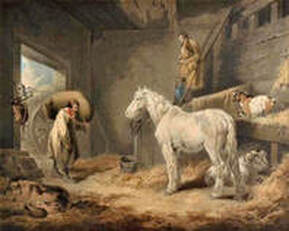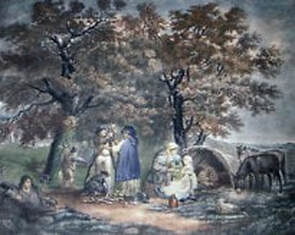Engravings
|
Research by Anne Matthews and Marjorie Gregson
|
|
ARTIST
George Morland, the eldest of five children, was born in the Haymarket, London on 26 June 1763, to artist and engraver, Henry Robert Morland (c1716-1793) and Jenny Lacam. Henry is best remembered for a portrait of King George III. His own father, George Henry Morland (died 1789), was also an artist. Educated at home, George took to copying pictures and plaster casts and first exhibited at the Royal Academy at the age of ten (chalk drawings). Apprenticed to his father from 1777 to 1784 he was encouraged to copy pictures, especially of Dutch and Flemish masters, including Fuseli's Nightmare, which his father then sold. In 1780, before he was seventeen, and already gaining a considerable reputation, his picture, Angler's Repast, was the subject of a fine engraving by William Ward and in 1781 his first oil painting, 'A Hovel with Asses', was exhibited at the Royal Academy. At the expiry of his apprenticeship in 1784 Morland refused an offer to join Romney's studio and entered the Royal Academy Schools but left after six months, possibly as a reaction to the restrictions placed on him by his father during his apprenticeship. Morland then moved to Margate and paid a short visit to France in 1785 before returning to London. In July 1786 he married Anne Ward, the sister of William Ward, the bond between the families being strengthened a month later when William married George's sister, Maria, the two couples setting up home together in High Street, Marylebone. After settling in London, Morland was now becoming well-known through Ward's engravings of his pictures, many of a sentimental rustic genre, which satisfied a steady public demand for the picturesque. He was also fond of visiting the Isle of Wight, where he painted his best coastal scenes depicting fishermen and smugglers. Eventually, he and Anne moved to Paddington and it was probably there that he painted the celebrated picture The Inside of a Stable, now in the National Gallery and which was exhibited at the Royal Academy in 1791. The stable is said to be that of the White Lion Inn at Paddington opposite to where he lived. Morland's best work occurred between 1787 and 1794 - from 1788 to 1792 inclusive over one hundred engravings after Morland were published. These covered a wide range of subject matter, charming scenes such as Children Bird Nesting and Children Playing at Soldiers, and scenes of moral contrast, The Fruits of Earl Industry and Economy and the Comforts of Industry, both published in 1790. His natural scenes of animals, cottage life, stables and groups of ordinary people were executed with a fine attention to detail. He exhibited regularly at the Royal Academy from 1784 to 1804. Amongst these was the remarkable 1788 picture Execrable Human Traffic or the Affectionate Slaves. Two years later he exhibited a companion painting showing Africans caring for shipwrecked Europeans. They were subsequently published as prints and served to promote abolitionism. However, Morland's success had allowed him to have the resources to lead a wild lifestyle from quite an early age. After 1794 his painting deteriorated as he alternated between periods of hard work and hard drinking until he was finally arrested for debt in 1799. By this time his health was in a perilous state and he subsequently suffered palsy, losing the use of his left hand, which meant he could no longer hold his palette. Despite this he went on painting. He died in a sponging house, Eyre Street, Cold Bath Fields on 27 October 1804, aged 41. WILLIAM WARD, ENGRAVER William Ward, born in London in 1762, was the son of James and Rachael Ward. He was the most distinguished pupil of J Raphael Smith and executed a great number of the plates which bear his name. In 1795 he began to exhibit in the Royal Academy, of which in 1814 he was elected an associate engraver. He also held the appointment of mezzotint engraver to the Prince Regent and the Duke of York. During the same period William's brother, James, became one of the outstanding artists of the day, his singular style and great skill set him above most of his contemporaries, markedly influencing the growth of British Art. He started off as an engraver, trained by William, who later engraved much of his work. The partnership of William and James Ward produced the best that English art had to offer, their great technical skill and artistry leading to images that reflected the charm of the era. In addition to engraving many of the works of his brother-in-law, George Morland, his output included six plates after Reynolds and full lengths of Sir David Wilkie and Patrick Brydone. He is associated with 167 portraits in the National Portrait Gallery in addition to works being held in the British Museum and the Royal Academy. He died in London in December 1826. JOSEPH GROZER - ENGRAVER Joseph Grozer was an English artist and printmaker, residing at 8 Castle Street, Leicester Square, London. He engraved in mezzoprint, after Sir Joshua Reynolds, George Romney and others. Amongst his earliest engravings are The Young Shepherd (1784) and the Theory of Design (1785), both by Reynolds. It was Grozer who gave the name The Age of Innocence to his stipple engraving of the work of Sir Joshua Reynolds, originally believed to have been called 'A Little Girl'. The picture became a favourite with the public, being described by Martin Postle of the Tate Gallery, where the painting resides, as "the commercial face of childhood", being reproduced countless times. |
REFERENCES
www.tate.org - biography link to wikipedia www.nga.gov.collection.artist-info.1735.html www.rountreetryon.com/artists/401-george-morland-biography www.royalacademy.org wikisource.org/wiki/1911/ Encyclopedia_Britannica artnet.com invaluable.com |


